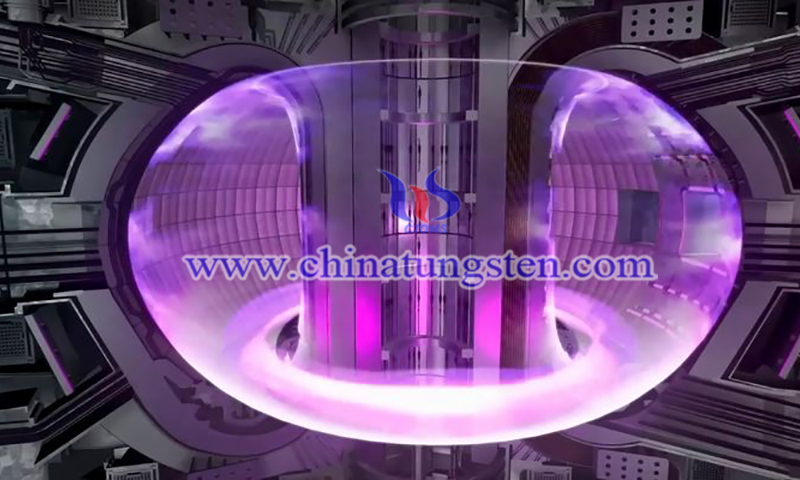Scientists Apply Boron to Tungsten Components in Fusion Facilities
- Details
- Category: Tungsten's News
- Published on Friday, 30 September 2022 22:28
Scientists from CEA, Oak Ridge National Laboratory, and France's École Polytechnique have succeeded in dropping boron (B) powder into a high-temperature plasma inside a tokamak made of tungsten components.
What is the connection between B, an element commonly found in household cleaners, and tokamaks, the ring-shaped nuclear fusion facilities that heat fuel to millions of degrees? Research conducted by scientists at the U.S. Department of Energy's (DOE) Princeton Plasma Physics Laboratory (PPPL) has shown that PPPL has developed a powder dripper that can successfully drip B powder into the high-temperature plasma inside the tokamak, whose components are made of a heat-resistant material called tungsten.
The scientists wanted to confirm that they could use this process to apply boron to tungsten parts because the exposed tungsten walls would compromise the plasma's properties if the plasma damaged the tungsten.
Because of its high melting point, tungsten is increasingly being used in tokamaks to help components withstand the high heat of the fusion process. B partially shields tungsten from contact with the plasma and prevents tungsten from leaking into the plasma; it also absorbs any stray elements in the plasma that may come from other sources, such as oxygen. These unwanted impurities may cool the plasma and quench the fusion reaction.

(Picture source: labmanager.com)
We needed a way to deposit a boron coating without turning off the tokamak magnetic field, and that's exactly what the powder dropper allowed us to do," said Grant Bodner, a postdoctoral researcher at PPPL and lead author of the research paper reporting the results in Nuclear Fusion. The research was conducted using a steady-state tokamak in a W environment (WEST) operated by the French Atomic Energy Commission (CEA).
Bodner added, "WEST is one of the few all-tungsten environments that can help us test this technology at long pulses."
Another reason physicists are using WEST for their experiments is that its magnets are made of superconducting material, a material that will play a role in the magnets inside future fusion devices. The material conducts electricity with little resistance and generates little excess heat, so the magnets can operate uninterrupted for long periods of time, just as future fusion reactors must do. The magnets create the force that confines the plasma and allows it to undergo fusion.
Nuclear fusion, which drives the sun and stars, combines light elements in the form of plasma - a hot, charged state of matter composed of free electrons and atomic nuclei - to produce massive amounts of energy. Scientists are seeking to replicate nuclear fusion on Earth to obtain an almost inexhaustible supply of electricity.
Scientists need a way to replenish the B coating while the machine is running because future fusion facilities won't be able to shut down as often for recoating. "Putting boron on a tokamak while it's running is like cleaning your apartment while doing all the other things you normally do in there, which is very helpful - it means you don't have to take extra time out of your usual activities to do the cleaning," CEA scientist Alberto Gallo, who contributed to the study Alberto Gallo said.
The powder-dropper mechanism is mounted on top of the tokamak and uses precise actuators to move the powdered materials from their reservoirs into the vacuum chamber of the tokamak. This mechanism allows researchers to precisely set the speed and duration of powder drops, which in other fusion facilities can include other performance-enhancing materials, such as lithium. Because of this flexibility, the dropper has the potential to make a real difference in the future.

(Picture source: SciTechDaily)
The researchers were surprised to find that the boron laid down by the dropper did more than regulate the inner surface of the tungsten. Bodner said, "we saw that when we dropped in the powder, the confinement of the plasma increased, which means it retained more heat, which helps the fusion process."
The confinement improvement is particularly helpful because it occurs without putting the plasma into a state known as H-mode (high confinement mode), where confinement is improved but the plasma is more likely to burst into what are called edge-located modes, or ELMs. These ELMs move heat out of the plasma, reducing the efficiency of the fusion reaction and sometimes damaging internal tungsten components. Bodner said, "If we can use the dropper to get a good constraint on the H-mode without actually going into the H-mode and risking ELMs, that would be very good for the fusion reactor."
"In the future, researchers hope to test the use of drops only when necessary to maintain good plasma performance. Adding any additional impurities, even boron reduces the fusion power you get because the plasma becomes less pure. So we had to try to use the smallest amount of B that would still produce the effect we wanted." Bodner said.
(Article source: www.sciencedaily.com)
- Tungsten Manufacturer & Supplier, Chinatungsten Online: www.chinatungsten.com
- Tungsten News & Prices of China Tungsten Industry Association: www.ctia.com.cn
- Molybdenum News & Price: news.molybdenum.com.cn
- Tel.: 86 592 5129696; Fax: 86 592 5129797; Email: sales@chinatungsten.com



 sales@chinatungsten.com
sales@chinatungsten.com